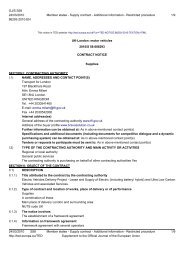Life cycle costing (LCC) as a contribution to sustainable construction ...
Life cycle costing (LCC) as a contribution to sustainable construction ...
Life cycle costing (LCC) as a contribution to sustainable construction ...
Create successful ePaper yourself
Turn your PDF publications into a flip-book with our unique Google optimized e-Paper software.
Towards a common European methodology for <strong>Life</strong> Cycle Costing (<strong>LCC</strong>) – Guidance Document<br />
17<br />
Bidders are also likely <strong>to</strong> carry out <strong>LCC</strong> <strong>as</strong>sessments of alternative design/specification<br />
options at this stage.<br />
During the tender stages the Public Sec<strong>to</strong>r client may also prepare its own <strong>LCC</strong> models<br />
b<strong>as</strong>ed on an exemplar design (often referred <strong>to</strong> <strong>as</strong> a Public Sec<strong>to</strong>r Compara<strong>to</strong>r), <strong>as</strong> a<br />
means of evaluating the <strong>LCC</strong> models submitted by the bidders.<br />
Further refinement of life <strong>cycle</strong> costs may occur <strong>as</strong> part of the short-listing of bidders. A<br />
due diligence exercise is also likely <strong>to</strong> be carried out by both the client and the bidder’s<br />
funders.<br />
Once a preferred bidder is selected the detailed <strong>LCC</strong> models setting out the expected<br />
expenditure throughout the concession period are incorporated in<strong>to</strong> project financial<br />
models and contracts. For example, the provider may sub-contract defined maintenance<br />
and replacement works <strong>to</strong> a third party, or the Public Sec<strong>to</strong>r client may specify<br />
replacement periods for key elements in the contracts.<br />
During <strong>construction</strong> and operation of the facility the detailed <strong>LCC</strong> models are updated <strong>to</strong><br />
reflect any changes or variations in the project, or in the specification of components and<br />
materials within it.<br />
The <strong>LCC</strong> models are regularly updated throughout the concession period and are used <strong>as</strong><br />
a <strong>to</strong>ol for managing maintenance and replacement works and for ensuring the necessary<br />
funding for such works is in place. The client may also used the models <strong>as</strong> a moni<strong>to</strong>ring<br />
<strong>to</strong>ol <strong>to</strong> ensure the necessary works are being carried out.<br />
4.4 How the Methodology supports Sustainability<br />
Sustainability is now a critical consideration affecting the design, <strong>construction</strong>, operation and<br />
disposal of constructed <strong>as</strong>sets. The <strong>LCC</strong> Methodology is a key element in supporting<br />
improvements in the sustainability of the built environment, by providing a common means<br />
for all costs <strong>as</strong>sociated with constructed <strong>as</strong>sets <strong>to</strong> be <strong>as</strong>sessed and compared on a comparable<br />
b<strong>as</strong>is.<br />
The environmental impact of constructing and maintaining the built environment is a<br />
particularly important element of sustainability. In general, the materials and products used<br />
in <strong>construction</strong> cause environmental impacts due <strong>to</strong> the interrelated processes of<br />
manufacture, transport, <strong>as</strong>sembly/dis<strong>as</strong>sembly, maintenance and disposal <strong>as</strong>sociated with<br />
them. Additionally, constructed facilities generate a significant environmental impact in<br />
their own right due <strong>to</strong> the operations carried out on and within them. Taken <strong>to</strong>gether, these<br />
environmental impacts are highly significant and should be addressed at the design/project<br />
planning stage of works projects.<br />
The <strong>LCC</strong> Methodology allows for the <strong>as</strong>sessment of the cost effects of these impacts, so that<br />
balanced decisions can be made on the life <strong>cycle</strong> costs of mitigating/reducing environmental<br />
impact. Additionally, the Methodology identifies ‘opportunity points’ for the <strong>as</strong>sessment of<br />
the cost impacts of the results of environmental analysis (such <strong>as</strong> <strong>Life</strong> Cycle Assessment –<br />
LCA). Whilst it is not yet possible <strong>to</strong> integrate fully the results of <strong>LCC</strong> with environmental<br />
<strong>as</strong>sessment methodologies such <strong>as</strong> LCA – and this <strong>to</strong>pic is covered further in Section 2.6 of<br />
this Guide – it is important <strong>to</strong> ensure that the cost implications of environmental impact are<br />
fully unders<strong>to</strong>od and taken account of in an <strong>LCC</strong> analysis. This will help ensure that best<br />
value solutions in both economic and environmental terms are identified.<br />
Davis Langdon Management Consulting May 2007







